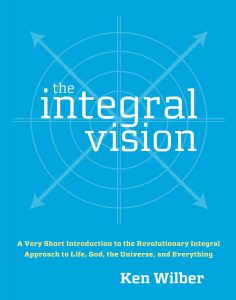This is a book summary of The Integral Vision: A Very Short Introduction by Ken Wilber (Amazon).
🔒 Premium members have access to the companion post: Integral Psychology & Spirituality Synthesis: How to Develop Holistically (10+ Visuals)
Quick Housekeeping:
- All quotes are from the author unless otherwise stated.
- Quotes are grouped by my own themes (not the author’s chapters).
- I’ve added my own emphasis to quotes in bold.
Book Summary Contents: Click a link to jump to a section below
- Introduction
- States of Consciousness
- Stages of Development
- Lines of Development
- Types
- AQAL
- Pre/Trans Fallacy
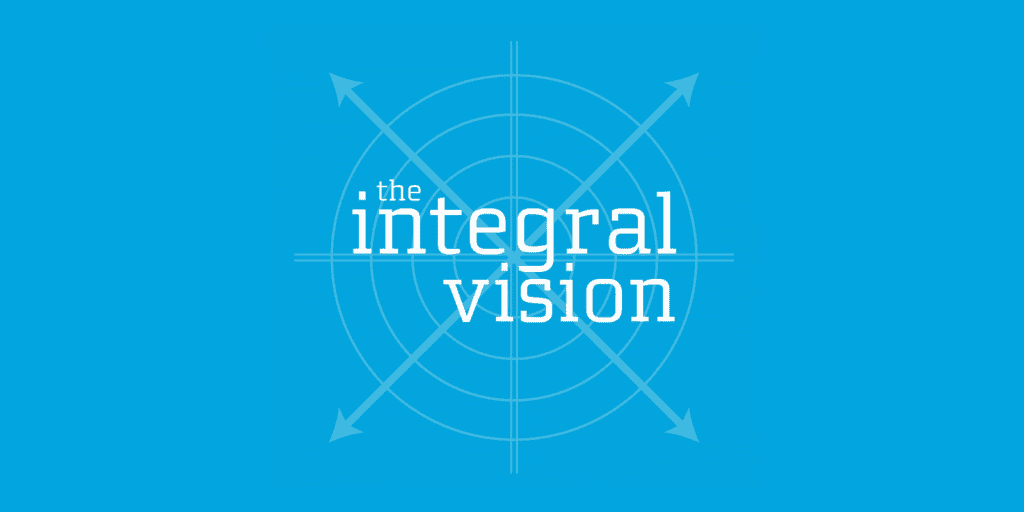
An Introduction to Integral Theory: The Integral Vision by Ken Wilber (Book Summary)
Introduction to The Integral Vision
“The Integral Approach involves the cultivation of body, mind, and spirit in self, culture, and nature.”
- “What if we took literally everything that all the various cultures have to tell us about human potential—about spiritual growth, psychological growth, social growth—and put it all on the table?”
- “What if we attempted to find the critically essential keys to human growth, based on the sum total of human knowledge now open to us?”
- “What if we attempted, based on extensive cross-cultural study, to use all of the world’s great traditions to create a composite map, a comprehensive map, an all-inclusive or integral map that included the best elements from all of them?”
- “This map uses all the known systems and models of human growth … and distills their major components into 5 simple factors … quadrants, levels, lines, states, and types.”
- “By using the Integral Approach—by using an Integral Map or Integral Operating System (IOS)—we are able to facilitate and dramatically accelerate cross-disciplinary and trans-disciplinary knowledge.”
- “Integral Theory might be the first truly comprehensive world philosophy.”
- “Most importantly, there is indeed a place for everything in your life. Everything has meaning, because everything fits. Meaning returns to one’s life. This is perhaps the single most important and quickly noticeable item about the Integral Approach: everything fits, and thus meaning returns.”
States of Consciousness
Temporary, subjective realities.
Examples:
- Waking, dreaming, deep sleep
- Meditative states, altered states, peak experiences
Example from wisdom traditions:
- “Because each of us has the 3 great states of consciousness—waking, dreaming, and formless sleep—the wisdom traditions maintain that each of us likewise has 3 bodies, which are often called the gross body, the subtle body, and the causal body.”
- Waking state — aware of gross body (physical, material, sensorimotor body)
- Dream state — subtle body of light, energy, emotional feelings, fluid and flowing images
- Deep sleep (formless state) — thoughts and images drop away, and there is only a vast emptiness, a formless expanse beyond any individual “I” or ego or self (causal body, the body of the finest, most subtle experience possible)
Important distinction:
- “The more you are plunged into authentic higher states of consciousness, the faster you will grow and develop through any of the stages of consciousness.”
Stages (or Levels, Waves) of Development
“Progressive and permanent milestones along the evolutionary path of your own unfolding.”
Overview:
- “If we put all of the scientific research on human development together, it appears that there are indeed at least these three broad arcs of human psychological growth: prepersonal to personal to transpersonal, or pre-rational to rational to trans-rational, or subconscious to self-conscious to super-conscious. Each of the stages in those arcs continues to transcend and include its predecessor(s). As each new level unfolds, it enfolds its predecessor—a development that is envelopment—so that the cumulative effect is integral indeed.”
Nested hierarchies:
- “Each stage represents a level of organization or a level of complexity.”
- “There are important emergent qualities that tend to come into being in a discrete or quantum-like fashion, and these development jumps or levels are important aspects of many natural phenomena.”
- “Growth hierarchies are always nested hierarchies, which means that each higher level transcends and includes its predecessors.”
- “Growth is a development that is envelopment.“
- “Growth or developmental hierarchies classically move, in humans, from egocentric to ethnocentric to worldcentric to Kosmocentric.”
- “Stages build upon their predecessors in very concrete ways, so they cannot be skipped: like atoms to molecules to cells to organisms.”
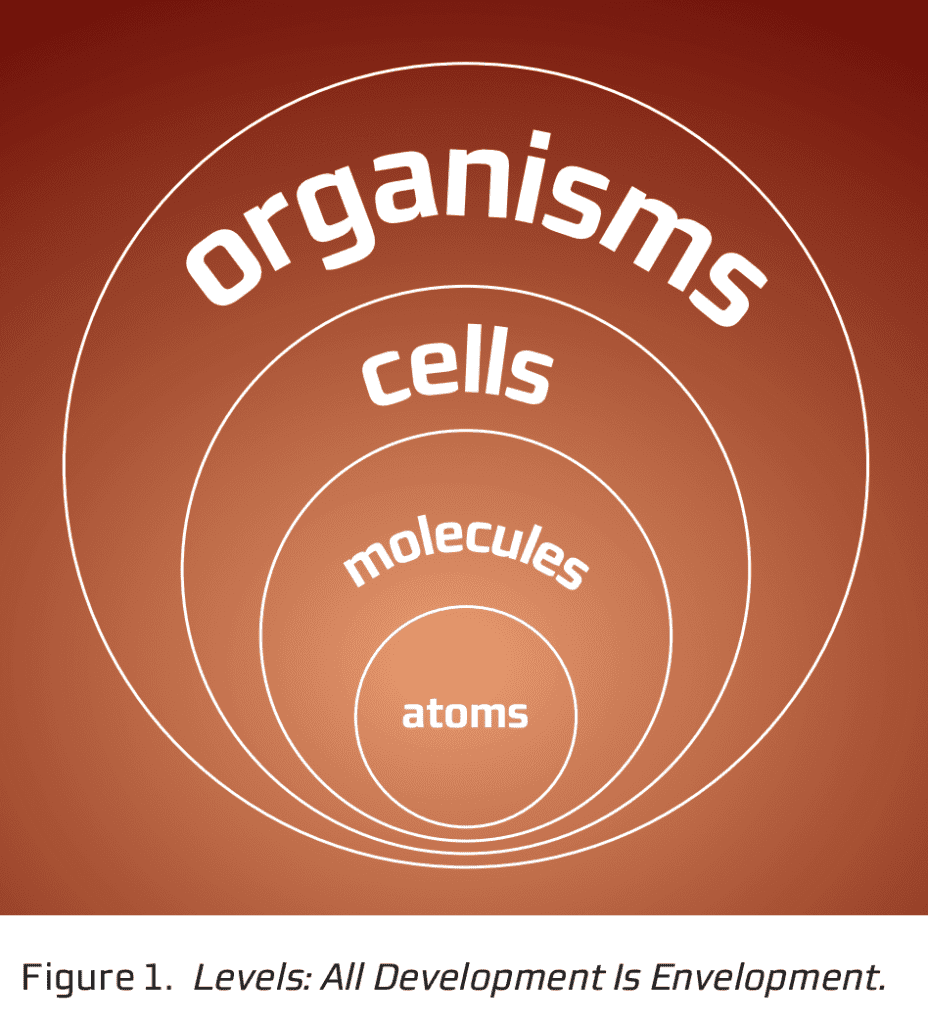
First, Second, & Third Tiers of Development:
- “All of the stages in first tier believe firmly that their values are the only true and correct values; everybody else’s are deeply confused.”
- “The developmental leap from first tier to second tier is a leap from fragmentation and alienation to wholeness and integration, from nihilism and irony to deep meaning and value.”
- “Starting with the leap to second tier—or the beginning of the truly integral levels—it is understood that all of the other values and stages are correct in their own ways, or are appropriate for their own levels. Second tier makes room for all of the other vales, and begins to pull them all together and integrate them into larger tapestries of care and inclusivity.”
- “In general, the first tier of growth involves moving from prepersonal to personal development; the second tier involves integrated personal development (and the beginning of the ‘integral’ stages); and the third tier involves transpersonal development (or the beginning of ‘super-integral’ stages).”
Lines (or Multiple Intelligences) of Development
“Each of us possesses at least a dozen major developmental lines.”
Overview:
- “Each multiple intelligence grows—or can grow—through the major stages.”
- “All of the following developmental lines can move through the basic levels/stages.”
Some of the most important lines/intelligences:
- Cognitive line (awareness of what is)
- Moral line (awareness of what should be)
- Emotional or affective line (the full spectrum of emotions)
- Interpersonal line (how I socially relate to others)
- Needs line (such as Maslow’s needs hierarchy)
- Self-Identity line (“Who am I?” Loevinger’s ego development)
- Aesthetic line (line of self-expression, beauty, art, felt meaning)
- Psychosexual line (entire spectrum of Eros: gross to subtle to causal)
- Spiritual line (where “spirit” is viewed not just as Ground, and not just as the highest stage, but as its own line of unfolding)
- Values line (made popular by Spiral Dynamics)
Notable People & Contributions:
- “Probably the most famous of the developmental sequences is that of Jean Gebser, which moves from archaic to magic to mythic to rational to pluralistic to integral.”
- “Abraham Maslow‘s meticulous research showed that individuals tend to move through a growth sequence of needs. As each lower need is met or fulfilled, a higher need tends to emerge.” (Note: Also see Maslow’s holarchy of needs)
- “Robert Kegan‘s work on orders of consciousness is probably some of the most widely respected anywhere. As is the sophisticated theory and research of Jane Loevinger on the stages of self development. One of Loevinger’s main students and successors, Susanne Gook-Greuter, has done significant research on the highest or third-tier levels of self development.”
- “Next we can look at the work of Clare Graves, on what he called value systems, and its popularization in a model called Spiral Dynamics (created by Don Beck and Christopher Cowan) … Clare Graves was one of the researchers who first discovered the incredibly important difference between the first tier and second tier of development.”
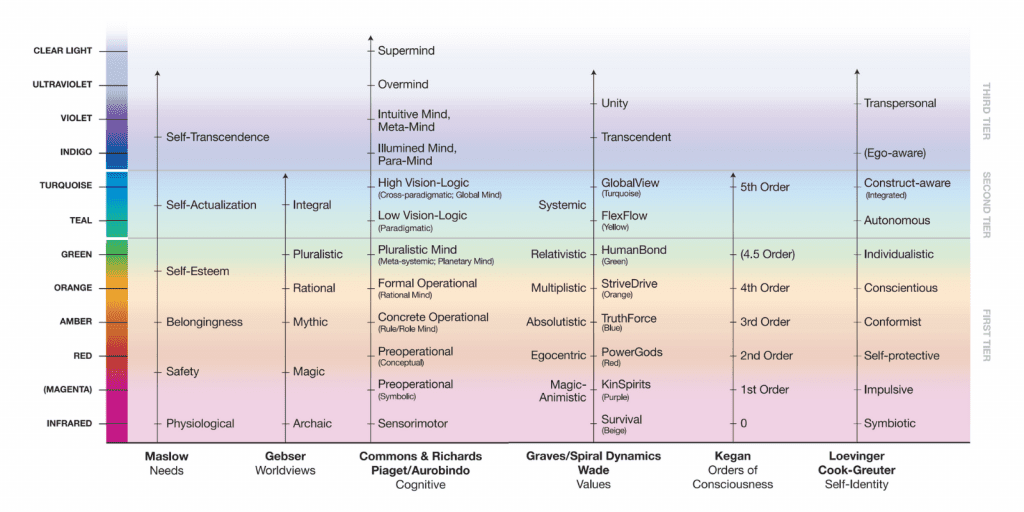
Types
“Types simply refers to items that can be present at virtually any stage or stage.”
Overview:
- “‘Types’ are as important as quadrants, levels, lines, and states.”
- “‘Horizontal typologies’ can be very useful, especially when combined with levels, lines, and states.”
- “You can have healthy and unhealthy versions of them.”
Examples:
- Myers-Briggs, Enneagram, etc — You can be any of those types at virtually any stage of development.
AQAL
“All Quadrants, All Levels, All Lines, All States, All Types” or simply “All Quadrants, All Levels”
Overview:
- AQAL is just another term for Integral Operating System (IOS) or the Integral Map.
- “The extraordinary complexity of humans and their relation to the universe can be simplified enormously by touching bases with the quadrants (the fact that every event can be looked at as an I, we, or it); developmental lines (or multiple intelligences), all of which move through developmental levels (from body to mind to spirit); with states and types at each of those levels.”
The Quadrants:
- “You can look at any event from the point of view of the ‘I’ (or how I personally see and feel about the event); from the point of view of the ‘we’ (how not just I but others see the event); and as an ‘it’ (or the objective facts of the event).”
- “So fundamental are these dimensions of ‘I,’ ‘we,’ and ‘it’ that we can call them the 3 quadrants … We arrive at 4 quadrants by subdividing ‘it’ into singular ‘it’ and plural ‘its.'”
- “The 4 quadrants—which are the 4 fundamental perspectives on any occasion (or the 4 basic ways of looking at anything)—turn out to be fairly simple: they are the inside and the outside of the individual and the collective.”
- “All 4 quadrants need to be included in any integral view.”
- “All 4 quadrants show growth, development, or evolution.”
Quadrant Breakdown:
- Upper-Left Quadrant (1st person, or “I,” the inside of the individual) — Self / Art / The Beautiful — Self, self-expression, art, aesthetics, beauty is in the eye of the beholder, your own immediate thoughts, feelings, sensations
- Lower-Left Quadrant (2nd person, or “YOU/WE,” the inside of the collective) — Culture / Morals / The Good — Ways that we treat each other (basic morality), cultural development
- Upper-Right Quadrant (3rd person, or “IT,” the outside of the individual) — Nature / Science / The True — Objective truth is best investigated by science, all of the exterior behavior, actions, and movements of my objective body (gross, subtle, or causal)
- Lower-Right Quadrant (“ITS,” the outside of the collective) — Systems theory investigates the collective social systems that evolve (unfolding levels of greater social complexity that are integrated into wider systems)
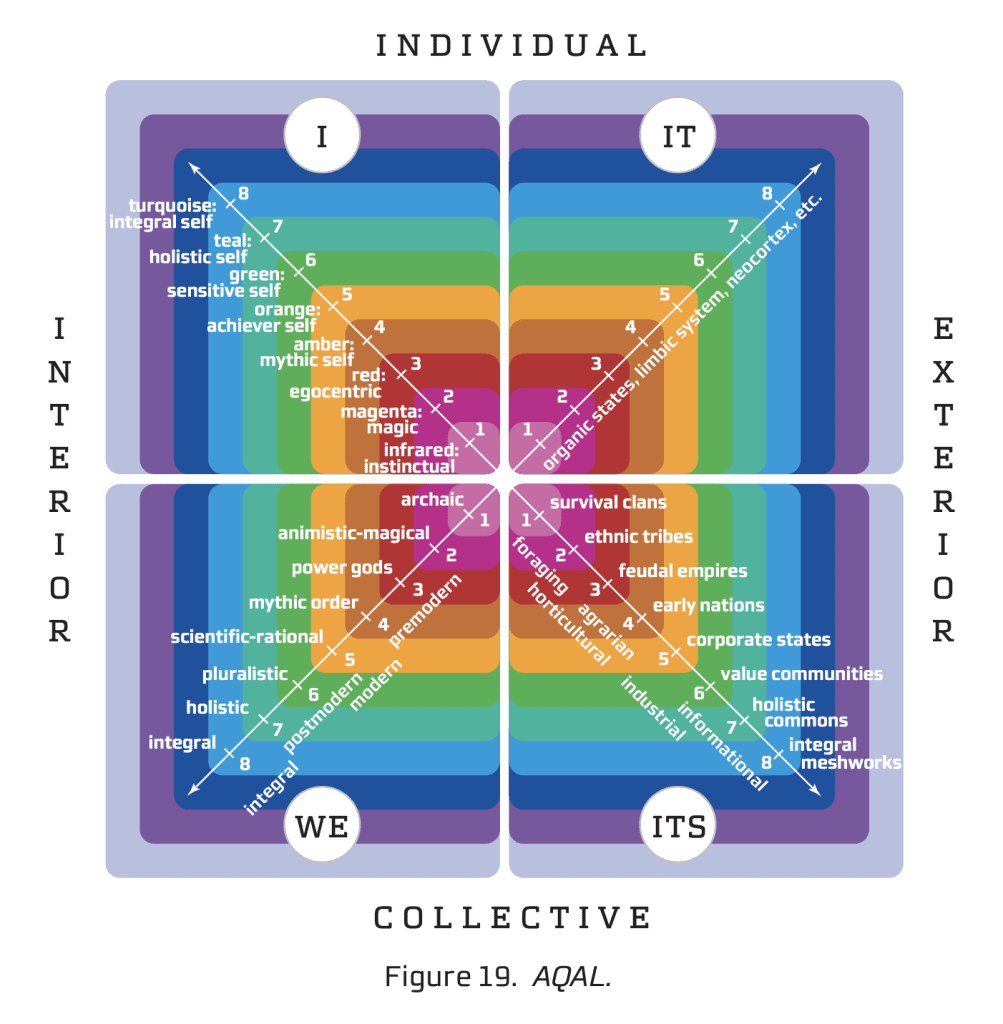
Pre/Trans Fallacy (or Pre/Post Fallacy)
“Because pre-conventional stages and post-conventional stages are both non-conventional, they are confused and even equated by the untutored eye.”
Overview:
- “Pre-rational stages are confused with trans-rational stages simply because both are nonrational; pre-egoic stages are confused with trans-egoic simply because both are non-egoic; transverbal is confused with preverbal because both are nonverbal, and so on.”
Two big mistakes:
- “People make one of two big mistakes. They either reduce all trans-rational realities to pre-rational childish twaddle (think Freud), or they elevate pre-rational childish images and myths to trans-rational glory (think Jung). Both reductionism and elevationism have plagued the discussion of spirituality from the beginning.”
Example:
- “The pre-rational and the trans-rational versions of spirituality sound similar or even identical to the untutored eye, simply because both are ‘nonrational,’ and hence they are treated as basically the same by anyone caught in this pre/trans fallacy, even though they are actually poles apart.”
You May Also Enjoy:
